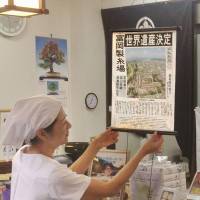A local newspaper in Gunma Prefecture issued a special edition made of silk on Sunday to mark the Saturday listing of the Tomioka Silk Mill as a World Cultural Heritage site.
The Jomo Shimbun newspaper produced 100 silk special editions measuring 50 by 40 cm and put them up in restaurants and souvenir shops near the mill, a historic factory building symbolizing the nation's industrialization from the 19th century.
The silk used for the extra issue was mostly produced in Gunma and woven by a company in the prefecture. A printing company in Tokyo produced the edition at a rate of a few copies per hour, because it takes longer to print on silk than conventional newsprint, according to the Jomo Shimbun.
An official of the newspaper expressed hope that the special edition will promote domestically made silk and rejuvenate the sericulture industry.
The Tomioka Silk Mill was built in 1872 as a government-run factory to serve as a model for other mills in Japan, eventually coming to play a leading role in the global silk industry.
Three related sites — the Tajima Yahei sericulture farmhouse in the Isesaki, the Takayama-sha sericulture school in Fujioka and the Arafune cold storage facility for silkworm eggs in the town of Shimonita — were included in the World Cultural Heritage listing maintained by the U.N. Educational, Scientific and Cultural Organization.



